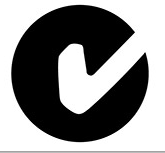
C-Tick certification
Manufacturers and importers must follow the next steps to use A-Tick:
1, the implementation of technical standards ACAQ product testing
2. Register A / C-Tick with ACA
3, fill in the "Declaration of Conformity" (Declaration of Conformity Form), and products and records consistent with the preservation
4, in the communications products or equipment affixed with A / C-Tick logo logo (label)
5, sales to consumers A-Tick applies only to communications products, electronic products are mostly for C-Tick, but if the application of electronic products A-Tick, you do not need to apply for another C-Tick.
If the products are to be sold in these two countries, the following documents must be prepared before they are marketed for the Australian Communications Authority (ACA) or the Ministry of Economic Development of New Zealand (New Zealand) ) The authorities at any time:
1. Test Report - Must be approved by NATA or NATA certification bodies, such as NVLAP or A2LA approved laboratory issued to be valid, otherwise the probability of sending samples to ask very high.
2. "Application to use the C-tick Mark" Form - must be signed by the Australian / New Zealand company or importers.
3. "Supplier's Declaration of Conformity" Form - must be signed by the Australian New Zealand company or importers. It is the responsibility of the manufacturer responsible for the signature to ensure that the products sold comply with the EMI requirements.
4. Original design drawings and specifications (such as: circuit diagram, block diagram, User's Manual and Service Manual, etc.).
5. Describe the production inspection procedures at the time of manufacture to ensure the maintenance of EMI characteristics.
6. Any change description and necessary test record that will affect EMI.
Certification period: 1-2 weeks.
Information on Australian suppliers must be provided alongside the C-Tick mark so that ACA can effectively trace back to the supplier responsible for the product EMC when sampling the product in the market. The identification of information includes four aspects:
1. The registered name and address of the Australian supplier
2. Australian Company Number
3. The number issued by the ACA to an Australian supplier
4. Products used in the Australian market in Australia registered trademark
C-Tick order label Radio communication equipment or special electrical and electronic equipment must comply with the relevant labeling requirements or can not be sold or supplied to Australia. The C-Tick is a sequential label that applies to the following label notices covered Of the material items
1. Radiocommunications (Sequential Label Launch Included) Notice 2001 Brief Description Conforms to EMC-adjusted Arrangements
2. Radio equipment (order label) notice No. 1 1996 We come to display briefing briefing Arrangement of compliance of radiocommunication
3. Radiocommunications (Sequential Labeling - Electromagnetic Radiation) Notice 2003 Brief Description Obey EMR Adjustment Arrangements
EMC adjustment arrangements, the product is available in Australia before the product must be affixed to the order label. It is also a sequential label for non-radiocommunication products that must comply with the electromagnetic emission (EMR) rule. For telecom products, the EMR is covered by the A-Tick sequence tag. The order tag on the C-Tick must have vendor information that identifies the vendor. This information may take the form of a supplier code issued by ACA, an Australian company number, or other forms detailed in the relevant label announcement. More information on the use of the C-Tick mark can be found on the ACA website.
Australia's EMC system divides the product into three levels. Suppliers must register with the ACA and apply for the C-Tick mark before selling products at level two or level three.
Level 1 refers to devices that use radio frequency spectrum interference products such as manual switches, simple relays, unidirectional squirrel-cage inductance motors, resistors and so on. For a Level 1 product, the supplier must sign a Declaration of Conformity and provide a product description. Level 1 products may voluntarily apply for the C-Tick mark, but after the supplier has chosen to use the mark, a compliance statement and product description should be provided along with a compliance record to demonstrate that the product described in the declaration Meet the relevant EMC standards. The test site is not required to allow internal testing.
Level II products refers to the use of wireless spectrum interference with higher radiation products, such as switching power supplies, welding machines, dimmers, most of the household appliances. In addition to the supplier must sign the compliance statement and provide product description, but also to provide the relevant standards of the test report, if there is no relevant standards, you need to provide technical structure documents, test sites not required to allow internal testing.
Level 3 products refers to the use of wireless spectrum interference with high radiation interference products, namely CISPR11 and CISPR22 products covered. At present, the communication terminal products are still included in this range, but from November 7, 2003, the end product will be divided into two products in the level. In addition to the supplier must sign a statement of compliance and provide product description, but also provide a test report issued by an accredited testing agency. At the same time also issued by the QSM certification body issued by the quality management system certificate.






